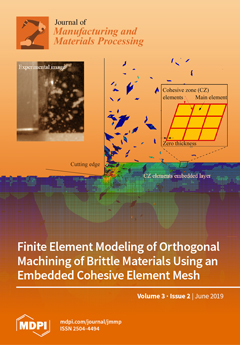The quality and reliability in additive manufacturing is an emerging area. To ensure process quality and reliability, the influence of all process parameters and conditions needs to be understood. The product quality and reliability characteristics, i.e., dimensional accuracy, precision, repeatability, and reproducibility are
[...] Read more.
The quality and reliability in additive manufacturing is an emerging area. To ensure process quality and reliability, the influence of all process parameters and conditions needs to be understood. The product quality and reliability characteristics, i.e., dimensional accuracy, precision, repeatability, and reproducibility are mostly affected by inherent and systematic manufacturing process variations. This paper presents research on dimensional quality and distortion analysis of AlSi10Mg thin-walled parts developed by a selective laser melting technique. The input process parameters were fixed, and the impact of inherent process variation on dimensional accuracy and precision was studied. The process stability and variability were examined under repeatability and reproducibility conditions. The sample length (horizontal dimension) results revealed a 0.05 mm maximum dimensional error, 0.0197 mm repeatability, and 0.0169 mm reproducibility. Similarly, in sample height (vertical dimension) results, 0.258 mm maximum dimensional error, 0.0237 mm repeatability, and 0.0863 mm reproducibility were observed. The effect of varying design thickness on thickness accuracy was analyzed, and regression analysis performed. The maximum 0.038 mm error and 0.018 mm standard deviation was observed for the 1 mm thickness sample, which significantly decreased for sample thickness ≥2 mm. The % error decreased exponentially with increasing sample thickness. The distortion analysis was performed to explore the effect of sample thickness on part distortion. The 0.5 mm thickness sample shows a very high distortion comparatively, and it is reduced significantly for >0.5 mm thickness samples. The study is further extended to examine the effect of solution heat treatment and artificial aging on the accuracy, precision, and distortion; however, it did not improve the results. Conclusively, the sample dimensions, i.e., length and height, have shown fluctuations due to inherent process characteristics under repeatability and reproducibility conditions. The ANOVA results revealed that sample length means are not statistically significantly different, whereas sample height means are significantly different. The horizontal dimensions in the
xy-plane have better accuracy and precision compared to the vertical dimension in the
z-axis. The accuracy and precision increased, whereas part distortion decreased with increasing thickness.
Full article





